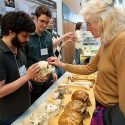Discovery building marks first anniversary with Gold LEED
When the Wisconsin Institutes for Discovery celebrates its first birthday this Friday, Dec. 2 at the University of Wisconsin–Madison, visitors can learn a new “first” about the building while taking a behind-the-scenes “green” tour or sharing locally sourced cake with Bucky.
The innovative building, which houses two research institutes and a main floor designed to engage the public in science, is the first laboratory building in Wisconsin to achieve LEED Gold certification as established by the U.S. Green Building Council.
“We initially aimed for silver due to the inherently high volume of energy and water used in a lab building,” says George Austin, building project manager for the Wisconsin Alumni Research Foundation, the partner in the private-public initiative responsible for construction. “We knew it would be challenging because laboratories require frequent air exchanges, purified water for lab experiments and often run equipment over nights and weekends. But as we completed certification documentation, we realized we had a chance for gold and applied for it. We were elated to learn the evaluators agreed.”
Campus and community members can see some of the behind-the-scenes features that impressed the LEED evaluators, and hear about the innovative science taking place on the facility’s research floors, during the one-year birthday celebration being held between 11 a.m. and 2 p.m. Friday.
Tour guides will lead new “green” tours every half-hour and full building tours on the hour. Visitor can take fossil and Mesozoic garden tours, go on a scavenger hunt to win prizes, and try hands-on stem cell, scientific instrument and computer gaming demos in the upper-floor teaching labs.
Seven “mini talks,” most presented by scientists in the building, will take place on the half hour. Between noon and 1 p.m. Bucky will visit and birthday cake will be served with all activities taking place at the Wisconsin Institutes for Discovery, 330 N. Orchard St., between University Avenue and Campus Drive.
The Wisconsin Institutes for Discovery, designed to use 50 percent less energy than a typical lab building on campus, achieved LEED certification for energy use, lighting, water and building materials as well as incorporating other sustainable strategies.
By using less energy and water, LEED certified buildings are designed to save money, reduce green house gas emissions and contribute to a healthier environment for residents, workers and the larger community. LEED is the nation’s preeminent program for the design, construction and operation of high-performance green buildings.
LEED certification was based on a number of green design and construction practices and features, such as:
- Recycling 98 percent of materials from site demolition to keep 7,000 tons of debris from being added to landfills and salvaging or recycling 92 percent of construction-related debris;
- Sourcing recycled and regionally manufactured products for more than 20 percent of the new building materials;
- Placing 75 geothermal wells 300 feet below ground to use the earth’s temperature to help heat or cool the building;
- Installing solar panels to generate hot water and reduce other energy used to heat the building;
- Capturing groundwater in cisterns and using it to water plants and using wastewater left over from water purification to flush low-flow toilets;
- Flushing hot or cold air from the building at night and directing desired energy back into the building;
- Installing chilled beams cooled by groundwater in warm areas such as computer rooms;
- Using glass for natural lighting and automatic window shades to limit exposure to heat and cold;
- Using high-performance terra cotta and recycled insulation on the exterior walls that act as a rain screen and provide exceptional air-tightness and resistance to outside temperatures, and;
- Providing “green” screens with real-time energy use data that allows building residents to track how their own behavior affects energy use.
“We couldn’t have selected a more talented and committed building team for this project,” says Carl Gulbrandsen, managing director of WARF and chair of the Wisconsin Institutes for Discovery building committee. “On behalf of our partners in this initiative, donors John and Tashia Morgridge, the state of Wisconsin and University of Wisconsin–Madison, we commend our architects, engineers, planners and construction professionals for completing an innovative and sustainable construction process. And, even more importantly, for building features into the facility so it will continue to conserve resources in its daily operations over many years to come.”
While the facility’s quest for LEED Gold has been completed, the tracking of its energy use and the study of the building occupants’ influence on it, are just beginning.
“The facility is becoming a living learning tool in a study by UW–Madison’s College of Engineering,” states John Nelson, an adjunct professor in Civil Engineering who also served as an engineering consultant on the project. “We want to find out if the building is performing the way we built it to perform. This study will hold us accountable and inform future building practices.”
The Wisconsin Institutes for Discovery has received 14 design and construction awards to date.
The design and building team of the Wisconsin Institutes for Discovery includes: Ballinger; Uihlein Wilson; Findorff| Mortenson, a joint venture; Affiliated Engineers; PSJ Engineering; UW–Madison Facilities, Planning and Management; Graef; Olin Partnership; Terra Engineering & Construction; Champion Environmental Services; General Heating and Air Conditioning; Westphal and Co.; Hooper Corporation; H.J. Martin & Son; and Construction Supply & Erection.
The Wisconsin Institutes for Discovery is a unique public/private initiative designed under one roof to facilitate interdisciplinary research and breakthrough discoveries to improve human health and wellbeing. It opened Dec. 2, 2010, in the heart of the campus and houses the private, nonprofit Morgridge Institute for Research, the UW–Madison’s public Wisconsin Institute for Discovery and a main floor called the Town Center that is designed to engage the public in science and learning.



